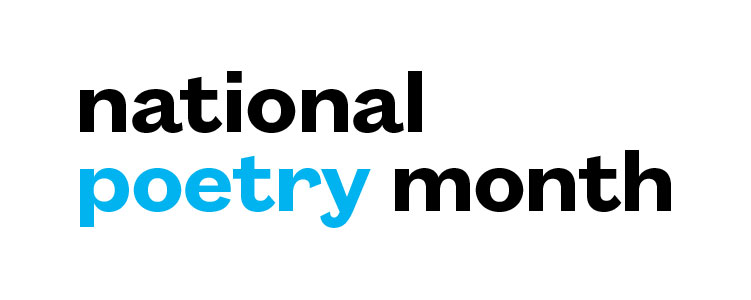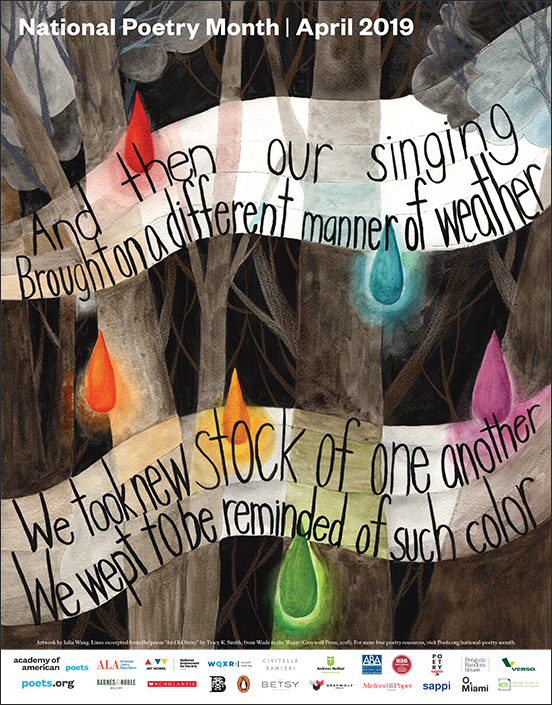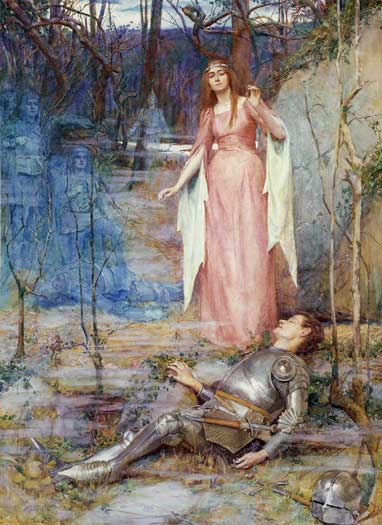
National Poetry Month was introduced in 1996 by the Academy of American Poets as a way to increase awareness and appreciation of poetry in the United States, and, since 1998, it’s also been celebrated in Canada. The idea for the celebration came when the Academy saw the success of Women’s History Month (in March) and Black History Month (in February), and wanted a way to celebrate and promote the work of poets, and the power of poetry. So, as a Library who always enjoys a celebration, we are happy to oblige!

Every year, the AAP put out a poster as part of the National Poetry Month campaign. You can see this year’s poster right above this paragraph. This year, for the very first time, the official National Poetry Month poster features artwork by a high school student: tenth grader Julia Wang from San Jose, California, who has won the inaugural National Poetry Month Poster Contest. Julia’s work incorporates quotes from the poem “An Old Story” by current U. S. Poet Laureate Tracy K. Smith. You can read more about Julia’s art, as well as the judges’ comments on her poster here!
Because one of our goals here at the Free For All is to bring a little poetry into your life, we are looking forward to sharing some verses with you this National Poetry Month. We’ll also be featuring a display table with poetry selections for you to savor.
 Today, we bring you and old favorite poem by John Keats (pictured on the left). Although now considered one of the leaders of the English Romantic movement, Keats wasn’t very well known in his life time, and died of tuberculosis at the age of 25. Born on October 31, 1795 to Thomas Keats, a hostler who worked with horses at the stables attached to the Swan and Hoop Inn (which he would later manage) and his wife, Frances Jennings. The family was unable to pay for an advanced education, so John was made an apprentice to a neighboring surgeon and apothecary named Thomas Hammond. Keats proved to be very talented at medicine, and enrolled at Guy’s Hospital (now part of King’s College London). However, the work detracted from his writing time, just at the time when Keats’ poetry was being recognized by literary scholars and publishers. Already suffering from health problems, Keats decided to leave London and move to Hampstead, where he helped his his brother nurse their other brother, Tom, who was dying of tuberculosis. It is thought that Keats may have contracted the condition around this time, most likely from his brother. His mother had also died of tuberculosis, which was known as the “family illness.”
Today, we bring you and old favorite poem by John Keats (pictured on the left). Although now considered one of the leaders of the English Romantic movement, Keats wasn’t very well known in his life time, and died of tuberculosis at the age of 25. Born on October 31, 1795 to Thomas Keats, a hostler who worked with horses at the stables attached to the Swan and Hoop Inn (which he would later manage) and his wife, Frances Jennings. The family was unable to pay for an advanced education, so John was made an apprentice to a neighboring surgeon and apothecary named Thomas Hammond. Keats proved to be very talented at medicine, and enrolled at Guy’s Hospital (now part of King’s College London). However, the work detracted from his writing time, just at the time when Keats’ poetry was being recognized by literary scholars and publishers. Already suffering from health problems, Keats decided to leave London and move to Hampstead, where he helped his his brother nurse their other brother, Tom, who was dying of tuberculosis. It is thought that Keats may have contracted the condition around this time, most likely from his brother. His mother had also died of tuberculosis, which was known as the “family illness.”
It was during this time that Keats met Fanny Brawne, who is believed to have been one of the most profound loves of his life. He and Brawne lived on the same property, and Keats wrote to her constantly. His health, however, was failing, and Keats was convinced by his friends to travel to Italy in 1820 the hope of saving his life. The trip was a disaster, however, marked by sudden storms at sea, a quarantine on board after a cholera scare, and resulted in Keats not arrived on land until November 1820, after the warm weather had already passed. He remained in Rome where his friends (who were physicians themselves) tended to him–however, the treatments of the day (which included starvation and bleeding) may very well have hastened Keats’ death, which occurred on February 23, 1821. His last request was for his grave to bear no name or date, only the words, “Here lies One whose Name was writ in Water.” His friends obliged.

Romantic poets aimed to identify and heighten extreme emotion through an emphasis on natural imagery, and Keats’ work is full of references to the scenery, animals, and beauty around him. This poem, about a fairy who condemns a knight to an unpleasant fate after she seduces him with her eyes and singing, is full of imagery and emotion, and is perhaps among one of Keats’ most well-known works. It has inspired a number of paintings and songs over the years, once of which you can see above this paragraph. So, without further ago, we invite you to savor:
La Belle Dame Sans Merci

